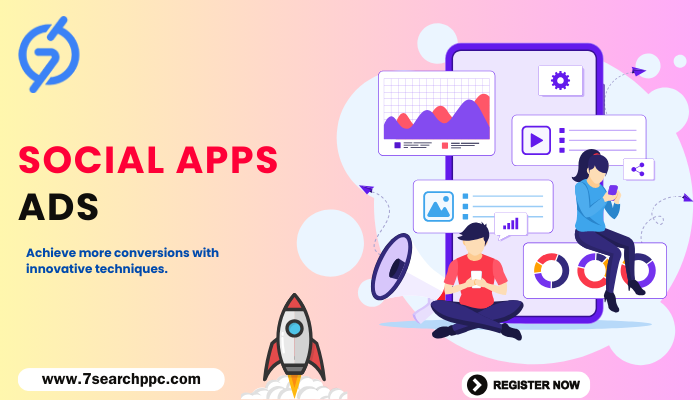Effective social apps advertising crucial for developers and companies looking to connect with their target audiences as the app market continues to expand at an exponential rate. A careful, data-driven approach is necessary to stand out in the millions of apps that are available in app stores. Making the most of your advertising budget is essential to making sure that your campaigns are economical, interesting.
The Importance of Budget Optimization in Social Apps Advertising
Why Social Apps Advertising Needs Optimization
When advertising on social apps, it’s easy to overspend without seeing the desired returns if you don’t have a well-optimized strategy in place. Proper optimization ensures that your marketing dollars are spent on audiences that are more likely to engage with and download your app. It also helps in balancing the need for awareness and conversions.
Key Benefits of Budget Optimization:
- Maximized ROI: Every dollar spent should be effectively driving app installs or user engagement.
- Targeted Reach: Optimization helps ensure that you reach the right people at the right time with relevant messaging.
- Lowered Cost Per Acquisition (CPA): Efficient budget allocation reduces the cost of acquiring new users by improving ad targeting and eliminating wasteful spend.
Leveraging Social Ad Networks for Broad Reach
A social ad network allows advertisers to display ads across various social platforms and apps, offering access to a large, diverse audience. Social ad networks like Meta Ads (Facebook, Instagram), Google Ads, and TikTok Ads streamline the process of running multiple campaigns across platforms, saving you time and effort.
Benefits of Social Ad Networks
- Wide Audience Reach: Social ad networks give you access to millions of users through multiple platforms.
- Centralized Campaign Management: Running ads across different platforms can be managed from one interface, improving efficiency.
- Advanced Targeting: Social ad networks offer sophisticated targeting options like age, interests, location, and behavior, ensuring that your ads reach the most relevant users.
Best Practices for Social Ad Network Optimization
- Know Your Audience: Use the audience segmentation tools offered by social ad networks to narrow down your target demographic.
- Set Clear Campaign Objectives: Whether it’s brand awareness, app installs, or user engagement, align your objectives with your budget allocation.
- Use Retargeting: Retarget users who have previously interacted with your app or ads to increase conversion rates.
Native Ads: Seamlessly Integrating Advertising with User Experience
Native ads are a popular format for social apps advertising because they blend seamlessly into the user experience. These ads look and feel like organic content, making them less disruptive and more engaging for users.
Why Native Ads Work for Social Apps Advertising
- Non-Intrusive Format: Native ads don’t interrupt the user’s experience, increasing the likelihood of engagement.
- Higher Click-Through Rates (CTR): Because they resemble regular content, users are more likely to interact with native ads.
- Better Brand Perception: Native ads are seen as more authentic and trustworthy compared to traditional banner ads or pop-ups.
How to Optimize Native Ads
- Ensure Relevance: Native ads should feel like a natural extension of the platform’s content. Tailor your ad copy and visuals to match the surrounding context.
- Use Engaging Visuals: Include high-quality images or video to capture attention and maintain user engagement.
- Experiment with Formats: Test different native ad formats—like videos, articles, or interactive content to see which resonates best with your audience.
Banner Ads: Simple Yet Effective in Driving App Awareness
Despite the rise of native and video ads, banner ads remain a staple of digital advertising. These ads, typically placed at the top or bottom of app screens, offer constant visibility without disrupting the user’s experience too much.
Advantages of Banner Ads in Social Apps Advertising
- High Visibility: Banner ads are always present on the user’s screen, ensuring constant exposure.
- Cost-Effective: Banner ads tend to be cheaper than other formats like native or video ads, making them an affordable option for advertisers on a budget.
- Quick Setup: Banner ads are relatively simple to create and deploy, making them a go-to for many advertisers.
Optimizing Banner Ads for Better Results
- Keep the Design Simple: Focus on a clear and concise message. Don’t overcrowd the banner with text or images.
- Use Strong Calls-to-Action (CTAs): Your CTA should stand out and compel users to click. Example: “Download Now” or “Get the App.”
- A/B Test Your Banners: Test different designs, messages, and CTAs to find the most effective combination.
CPM vs. PPC: Selecting the Right Pricing Model for Your Campaigns
Choosing between CPM (Cost per Mille) and PPC (Pay Per Click) is crucial in determining how you’ll pay for your ads and how that aligns with your campaign goals.
CPM (Cost per Mile)
With CPM, you pay a set rate for every 1,000 impressions of your ad. This model is ideal for brand awareness campaigns where you want your ad to be seen by as many users as possible, regardless of whether they click.
Benefits of CPM:
- Broad Exposure: CPM is perfect for gaining visibility among a large audience.
- Predictable Costs: You’ll know exactly how much you’re paying for every 1,000 impressions, which is useful for budgeting.
PPC (Pay Per Click)
In contrast, PPC charges advertisers only when a user clicks on the ad. This model is more suited for performance-driven campaigns where the goal is to drive app installs or other conversions.
Benefits of PPC:
- Only Pay for Engagement: PPC ensures that your budget is spent only when users interact with your ads.
- Better for Conversions: PPC campaigns are typically more focused on achieving tangible results like app downloads.
Which Model is Right for You?
- CPM is best for raising brand awareness and reaching a large audience.
- PPC is more effective when you want to focus on conversions and actions, such as driving app installs.
Using Ad Networks to Expand Your Reach and Scale Your Campaigns
An ad network is a platform that connects advertisers with multiple publishers to display ads across various sites and apps. Using an ad network simplifies the process of advertising across different platforms by centralizing campaign management.
How Ad Networks Benefit Social Apps Advertising
- Scalable Campaigns: Ad networks allow you to reach millions of users through multiple platforms without the need to manually manage separate campaigns.
- Efficient Budget Allocation: By using an ad network, you can optimize your budget to target users across different apps and platforms based on where your ads perform best.
- Advanced Reporting: Ad networks provide detailed performance data, enabling you to fine-tune your campaigns for better ROI.
Popular Ad Networks for Social Apps Advertising
- Google Ads: Google’s ad network offers reach across YouTube, Google Play, and partner apps.
- Meta Ads: Facebook and Instagram ads provide robust targeting options and extensive audience reach.
- TikTok Ads: Ideal for targeting younger demographics, TikTok Ads are highly engaging and effective for app promotions.
Best Practices for Optimizing Your Social Apps Advertising Budget
Optimizing your advertising budget requires a combination of strategic planning, data analysis, and flexibility. Here are some best practices to ensure that your social apps advertising budget delivers the best possible ROI.
Set Clear Goals
Before launching any campaign, define your objectives. Are you focused on driving app installs, increasing user engagement, or boosting brand awareness? Your budget allocation will depend heavily on these goals.
Target the Right Audience
Make use of social ad networks’ advanced targeting tools to narrow down your audience based on demographics, behaviors, and interests. This reduces wasted spend on users who are unlikely to engage with your app.
Test Different Ad Formats
Experiment with various ad formats like native ads, banner ads, video ads, and carousel ads to determine which ones perform best for your audience. A/B testing different elements such as ad copy, visuals, and CTAs can provide valuable insights.
Monitor Campaign Performance
Regularly review your campaign analytics to assess performance. Use this data to adjust your bids, targeting, or ad placements. Real-time monitoring is essential for ensuring that your budget is spent on ads that deliver results.
Adjust Bidding Strategies
Experiment with different bidding strategies, such as manual vs. automated bidding, to optimize your cost per click (CPC) or cost per thousand impressions (CPM). Adjusting bids can help you focus your spend on ads that yield the highest ROI.
Conclusion
A comprehensive strategy that includes choosing the best ad formats, utilizing social ad networks, and utilizing the right pricing models like CPM and PPC is needed to maximize your social apps advertising budget. You can increase the impact of your advertising and guarantee a higher return on investment for your app promotions by adhering to the best practices described in this article.
FAQs
What is advertising on social media apps?
Ans. The practice of promoting apps through sponsored ads on social media sites and within other apps is known as “social apps advertising.” To engage users and promote app installs, it uses a variety of ad formats, including native ads, banner ads, and video ads.
What distinguishes CPM from PPC in terms of app advertising?
Ans. Cost per mille, or CPM, is a great way to raise brand awareness because it charges advertisers for each 1,000 impressions of their advertisement. PPC (Pay Per Click) is better suited for campaigns that are conversion-focused because it only charges advertisers when a user clicks on the advertisement.
How can I maximize my advertising budget for social media apps?
Ans. Focus on specific objectives, employ advanced targeting, experiment with various ad formats, keep a close eye on performance, and modify your bidding tactics to guarantee cost-effective ad expenditure in order to maximize your budget.
Which ad networks are most effective for advertising social apps?
Ans. Google Ads, Meta Ads (Facebook and Instagram), and TikTok Ads are well-known ad networks for social app advertising because they provide broad reach and sophisticated targeting features.



